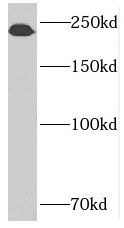Products
SUPT6H antibody
| Synonyms: | Transcription elongation factor SPT6 (hSPT6)|Histone chaperone suppressor of Ty6|Tat-cotransactivator 2 protein (Tat-CT2 protein)|SUPT6H|KIAA0162|SPT6H antibody | ||
| Catalogue No.: | FNab08395 | Reactivity: | Human, Mouse, Rat |
| Host: | Rabbit | Tested Application: | ELISA, WB, IP |
| Clonality: | polyclonal | Isotype: | IgG |
| Size | Price |
|---|---|
| 100µg | Inquiry |
- SPECIFICATIONS
- FIGURES
- CONDITIONS
- FAQS
- Product Name
- SUPT6H antibody
- Catalogue No.
- FNab08395
- Size
- 100μg
- Form
- liquid
- Purification
- Immunogen affinity purified
- Purity
- ≥95% as determined by SDS-PAGE
- Clonality
- polyclonal
- Isotype
- IgG
- Storage
- PBS with 0.02% sodium azide and 50% glycerol pH 7.3, -20℃ for 12 months(Avoid repeated freeze / thaw cycles.)
- Immunogen
- suppressor of Ty 6 homolog
- Alternative Names
- Transcription elongation factor SPT6 (hSPT6)|Histone chaperone suppressor of Ty6|Tat-cotransactivator 2 protein (Tat-CT2 protein)|SUPT6H|KIAA0162|SPT6H antibody
- UniProt ID
- Q7KZ85
- Observed MW
- 230 kDa
- Tested Applications
- ELISA, WB, IP
- Recommended dilution
- WB: 1:500-1:2000; IP: 1:200-1:2000
 HeLa cells were subjected to SDS PAGE followed by western blot with FNab08395(SUPT6H antibody) at dilution of 1:1000
HeLa cells were subjected to SDS PAGE followed by western blot with FNab08395(SUPT6H antibody) at dilution of 1:1000
 IP Result of anti-SUPT6H (IP:FNab08395, 4ug; Detection:FNab08395 1:1000) with HEK-293 cells lysate 1200ug.
IP Result of anti-SUPT6H (IP:FNab08395, 4ug; Detection:FNab08395 1:1000) with HEK-293 cells lysate 1200ug.
- Background
- Transcription elongation factor which binds histone H3 and plays a key role in the regulation of transcription elongation and mRNA processing. Enhances the transcription elongation by RNA polymerase II(RNAPII) and is also required for the efficient activation of transcriptional elongation by the HIV-1 nuclear transcriptional activator, Tat. Besides chaperoning histones in transcription, acts to transport and splice mRNA by forming a complex with IWS1 and the C-terminal domain(CTD) of the RNAPII subunit RPB1(POLR2A). The SUPT6H:IWS1:CTD complex recruits mRNA export factors(ALYREF/THOC4, EXOSC10) as well as histone modifying enzymes(such as SETD2), to ensure proper mRNA splicing, efficient mRNA export and elongation-coupled H3K36 methylation, a signature chromatin mark of active transcription. SUPT6H via its association with SETD1A, regulates both class-switch recombination and somatic hypermutation through formation of H3K4me3 epigenetic marks on activation-induced cytidine deaminase(AICDA) target loci. Promotes the activation of the myogenic gene program by entailing erasure of the repressive H3K27me3 epigenetic mark through stabilization of the chromatin interaction of the H3K27 demethylase KDM6A.
How many times can antibodies be recycled?
First, usually it's not suggested to recycle antibodies. After use, buffer system of antibodies has changed. The storage condition of recycled antibodies for different customers also varies. Thus, the performance efficiency of recycled antibodies can’t be guaranteed. Besides, FineTest ever conducted the antibody recycling assay. Assay results show recycling times of different antibodies also varies. Usually, higher antibody titer allows more repeated use. Customers can determine based on experimental requirements.
Notes: After incubation, we recycle rest antibodies to centrifuge tube and store at 4℃. High titer antibodies can be stored for a minimum of one week. Reuse about three times.
What are components of FineTest antibody buffer?
Components of FineTest antibody buffer are usually PBS with proclin300 or sodium azide, BSA, 50% glycerol. Common preservative is proclin300 or sodium azide, which is widely applied in the lab and industry.
How about the storage temperature and duration of FineTest antibodies?
Most antibodies are stored at -20℃. Directly-labeled flow cytometry antibodies should be stored at 2 - 8℃. The shelf life is one year. If after sales issues for purchased antibodies appear, return or replacement is available. Usually, antibodies can be still used after the one-year warranty. We can offer technical support services.
Is dilution required for FineTest antibodies? What’s the dilute solution?
Directly-labeled flow cytometry antibodies are ready-to-use without dilution. Other antibodies are usually concentrated. Follow the dilution ratio suggested in the manual. Dilute solution for different experiments also varies. Common antibody dilution buffers are acceptable(e.g. PBST, TBST, antibody blocking buffer).
How to retrieve antibodies for immunohistochemistry?
Common retrieval buffers: Tris-EDTA Buffer(pH 9.0); Citrate Buffer(pH 6.0)
Heat induced antibody retrieval:
Method 1: Water-bath heating: Put the beaker with retrieval buffer and slide in the boiling water bath. Keep the boiling state for 15min. Naturally cool to room temperature;
Method 2: Microwave retrieval: Put the beaker with retrieval buffer and slide in the microwave oven. Heat at high power for 5min, Switch OFF for 3min, Heat at medium power for 5min. Naturally cool to room temperature.
How to choose secondary antibodies?
(1) Secondary antibodies react with primary antibodies. Thus, secondary antibodies should be against host species of primary antibodies. E.g. If the primary antibody is derived from rabbit, the relevant secondary antibody should be against rabbit. E.g. goat anti rabbit or donkey anti rabbit.
(2) Choose secondary antibody conjugates according to the experimental type, e.g. ELISA, WB, IHC etc. Common enzyme conjugated secondary antibodies are labelled by HRP, AP etc. Fluorescin or dye labelled secondary antibodies are applied in immunofluorescence and flow cytometry(e.g. FITC, Cy3).
